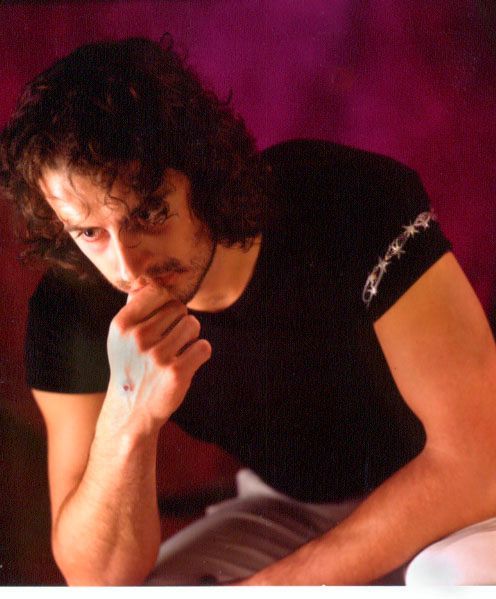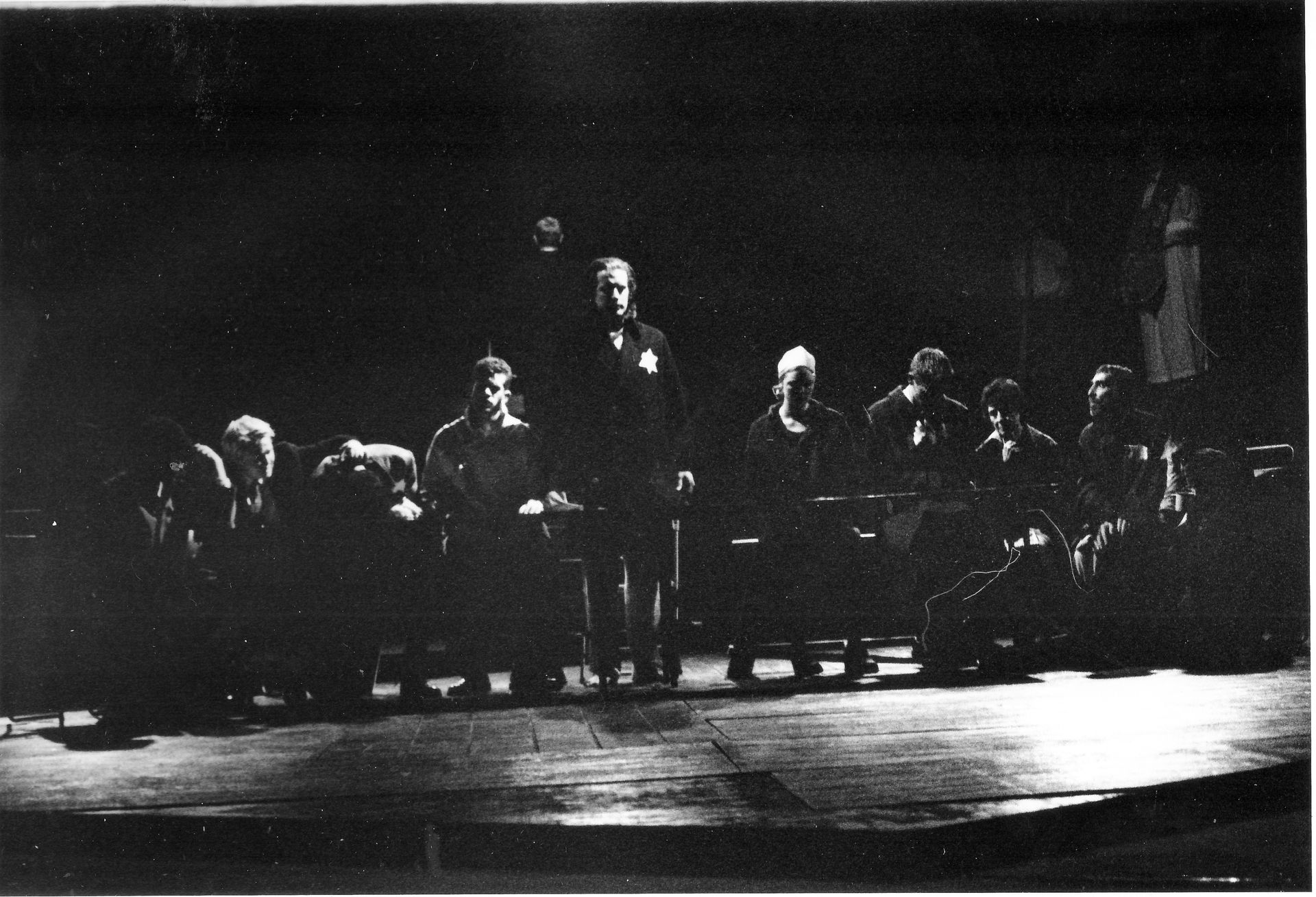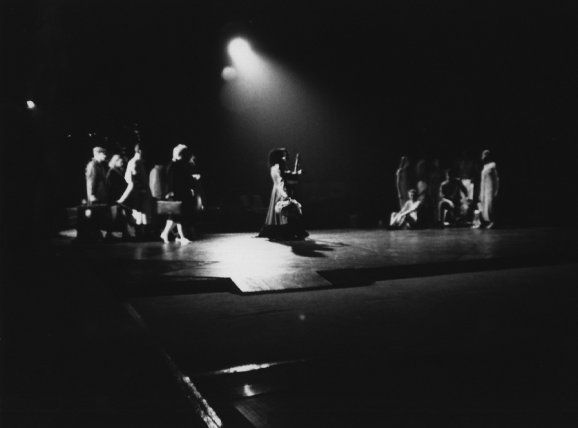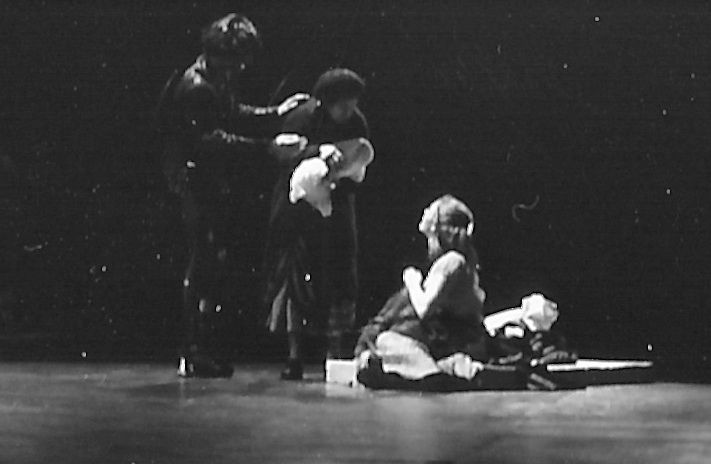Mysteries 2000
Performed
at the
SFX CITY THEATRE
November 1999
based on
the York Cycle of Medieval Mysteries plays
remade and reworked for the dawn of a new millennium by a number of leading writers
and dragged into life by an amazing cast of actors and musicians
MYSTERIES 2000
Creatives:
Director
Michael Scott
Designer
Bronwen Cassin
Costumes
Synan O Mahony
Music
Conor Linihan
Michael Scott
Producer
Avril Ryan
Stage Manager:
Eva Walsh
PHOTOS :
John Wreck (colour)
Bronwen Cassin (Black & White)
The Following 26 individual plays were performed (not in this order) - under the collective title of MYSTERIES 2000 –
they were performed one after each other and no attempt was made to join them together
all were directed by Michael Scott
Each play can be performed at any time without reference to the others – they are modern rewokings of the York Guild plays
2000 years after…
How should Jesus be represented today at the end of the twentieth century?
How can his life, his actions, and his teaching be communicated through modern means?
In our technologically led world, how can you communicate the timeless concept conveyed in the words “I am with you always; yes, to the end of the world?”
How do you reawaken the idea of discovering these essential stories as if for the first time?
The medieval mystery plays written were confirmations by the Church and State of their relationship to man.
But now, who have we to tell us who and where we are? It is to our poets and playwrights we must look, they pattern for us the unconscious dream-life of our culture.
Over the last ten years in particular, the relationship between Church and State has changed in Ireland. We must now ask anew what is faith, and what does it mean to be spiritual, who are we, and what is our relationship to God?
At the centre of this production of MYSTERIES 2000 lies the essential question for all theatre making;
Who are we playing for?
Can the theatre ask questions that are of relevance today?
Can the theatre still provoke us, or is it just an easy entertainment?
Photos :
John Wreck
(colour)
Bronwen Cassin
(Black & White)
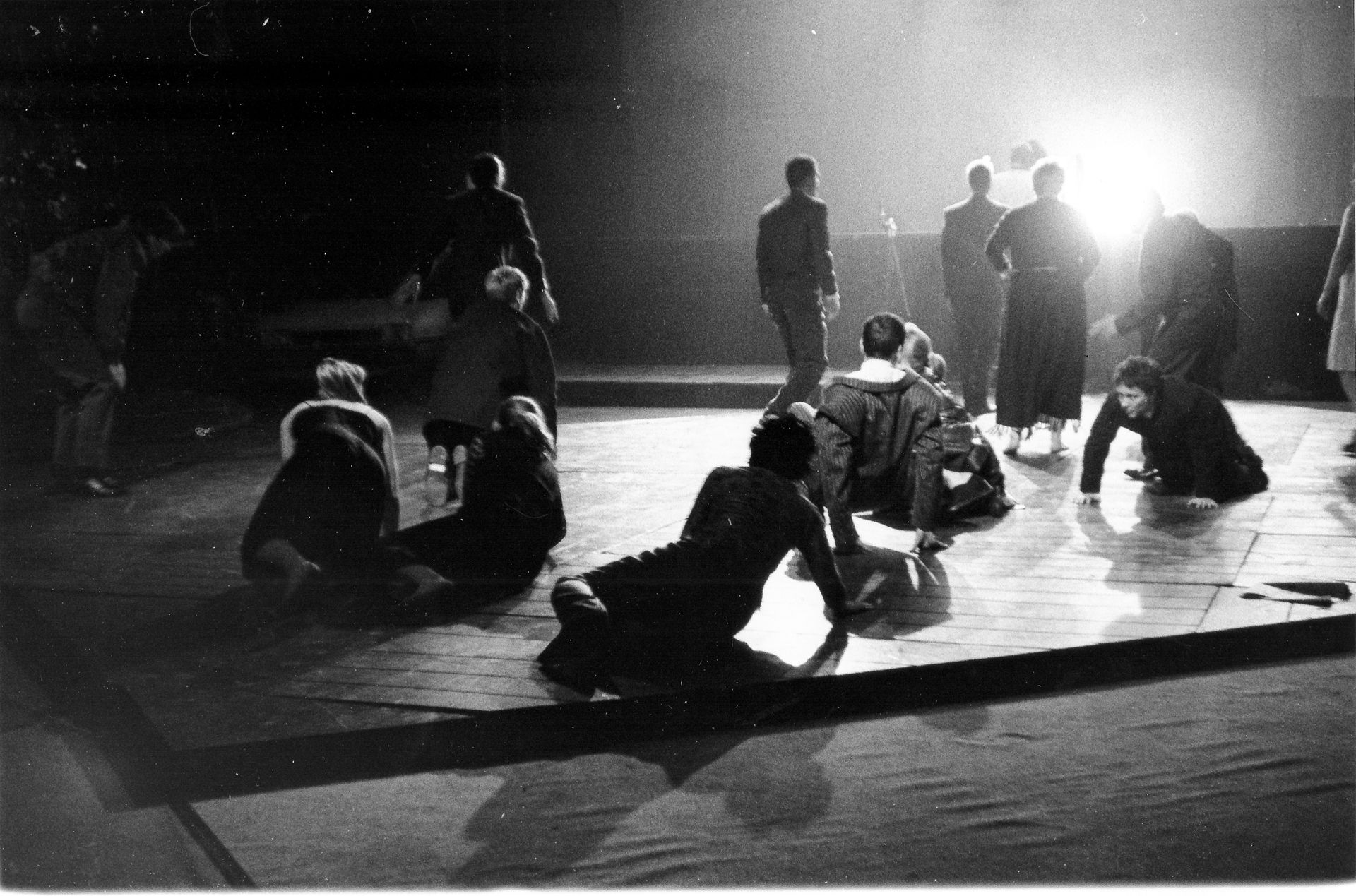
1. THE FALL OF LUCIFER
By Michael McCaffery
2. CREATION
By Michael McCaffery
3. JESUS MARY & JOSEPH
By Michael McCaffery
4. NATIVITY
By Michael McCaffery
5. JUDGEMENT DAY
By Michael McCaffery
6. LAZARUS By
Gavin Kostic
7. THE BUFFETING
By Gavin Kostic
8. THE HARROWING OF HELL
By Gavin Kostic
9. CAIN AND ABLE
By Aidan Matthews
10. THE LAST SUPPER
By Aidan Matthews
11. MY MIND OF QUESTIONS
By Brendan Kennelly
12. BETRAYAL
By Brendan Kennelly
13. TEMPTATION
By Joe O Connor
14. THE ADULTERESS WOMAN
By Joe O Connor
15. THE DEATH OF JUDAS
By Michael Scott
16. THE OMEAGA –
By Micahel Scott
17. PARLIAMENT OF HEAVEN
By Derek Chapman
18. COUNCIL OF JEWS
By Derek Chapman
19. THE DEATH OF HEROD
By Pat Kinivan
20. JOHN THE BAPTIST
By Declan Gorman
21. NOAH
By Fergus Linihan
22. ABRAHAN & ISSAC
By Johnny Hanrahan
23. MOSES
By Joe O Byrne
24. PILATES WIFE
By Mary Elizabeth Burke Kennedy
25. THE ASCENSION
By Deirdre Purcell
26. SONG OF SONGS
by Nuala Ni Dhomhnaill
Dramaturgs
Michael McCaffery
Derek Chapman
CAST
Lukas Hassel
Phyllis Ryan
John Matthews
Victor Bourke
Amy Conroy
Cynthia Buchan
Jimmy
Andre Edmunds
Sarah O Toole
The last recorded performances of the Mysteries were in Chester in 1574 and the plays remained largely neglected until the 1920s since when they have been increasingly revisited not merely as historical curiosities but as important dramatic statements which are capable of reinterpretation and investigation , retaining their plurality, diversity and power to provoke debate and meditation in equal measure.
The word "Mysteries" is derived from the Greeks who used it to describe a particular ritual which only the initiated might witness and whose contents they were sworn to keep secret. The "secret" underlying the Mediaeval Mysteries is of course, entirely open as the plays were for general consumption, but nevertheless this "mystery" had the sense and, indeed, the purpose of binding together the whole community in a common vision of the world. Underlying the entertainment and devotional aspects was a determined programme of social education and control. The city was the world scaled down and so the good conduct of the city and its citizens might be learned from the bigger picture.
The plays teach absolute obedience to one's masters (God) and the spiritual and material consequences of disobedience (Lucifer and Mankind).They enforce the legitimacy and propriety of laws made by external authorities (God again, this time with Moses) and explicitly state that the transgressor will be punished or obliterated.
They set up a chain of command from God the Father through the Prophets and John the Baptist to Christ and the Apostles and then the Church (only Catholic of course at this time) and show that State and Church rule the world together, representing the spiritual and temporal aspects of the Creator and that everyone is properly subject to them.
These values are uncompromisingly proclaimed in play after play and everything in the Mysteries---words, actions, pictures, sounds---is deployed to disseminate the propaganda of a dominant feudal church-state patriarchy, which, if denied or contradicted results in expulsion from the paradise (the city). This vision of a male-dominated world is reinforced by the fact that all the actors were male and that women are presented broadly as either occasions of sin or the route to redemption. The virgin-mother-whore triptych is depressingly reiterated throughout the original texts, emphasising on the whole, the importance the dominant community placed on the subjugation of women to maintain a "well-ordered and secure" society.The subtext, however, for the later reader is a dramatic world in which women are quite often the questioners, provokers, reasoners and instruments of change.
That the Mysteries were a site for political and religious (as opposed to spiritual) controversy is apparent from their careers after the English Reformation in 1536. Banned at first, they reappeared in edited and revised form during the remaining Tudor reigns, were briefly restored during the Catholic rule of Mary in the 1550s and finally excised during the 1570s under Elizabeth. After 1536 , the texts were heavily edited and brought into line with Protestant theologies but their content was increasingly out of sympathy with Elizabethan ideologies of Church and state. What had once been an instrument for inculcating the values of a particular ideologic for the very existence of religious diversity and conflicting views of social organisation. Paradoxically, these models of doctrinal conservatism came to represent a significant threat to the prevailing orthodoxies of late Tudor England and its dominions.
THE WORD WAS MADE FLESH..........
Between the fourteenth and sixteenth centuries, in almost every large town in these islands, a cycle of plays known as The Mysteries was performed throughout the year to celebrate or mark particular holidays (holy days) or important civic festivals. A double edged-sword, they skilfully provided entertainment and diversion amidst the solemnity of religion and a spiritual corrective to the remaining Pagan feasts celebrated throughout the year.
The cycles consisted of up to forty plays, depending on the communities producing them. Essentially, they covered the history of mankind from the creation of the world to its destruction by God at Judgement Day and they were performed in the open air from early morning until late evening.
Each play was entrusted to a particular group (one of the guilds or groups of merchants or manufacturers which made up mediaeval urban society) who then created a script, a production and a staging which it toured round the city on wagons, playing it perhaps at different locations .
Conversely the Pageant Wagons may simply have provided a convenient way of effecting multiple scene changes without keeping a potentially rowdy and possibly increasingly partying audience waiting.. As one of the points of the Cycle was to unfold or express a particular notion of society and its place in a great eternal plan, the importance of a smooth running and apparently seamless vision of humanity's journey was as much a visual metaphor for the divine scheme and the natural order as a practical consideration based on crowd control and good stage management.
The staging of the plays was often opulent and spectacular. One of their purposes , after all, was to represent in visual terms, those texts of the Bible which were inaccessible to the vast majority of the audience who could not read. The audience came to see the fall of Lucifer, the parting of the Red Sea, the Harrowing of Hell and Judgement Day, and while the mediaeval mind was more accustomed to the use of symbol than we are today, its relation to it was also different in that it saw the symbol as the outward manifestation of an internal truth rather than merely an image which stands in for something else either invisible or intangible in itself.
This was an audience whose faith centred on the belief that the Body and Blood of Christ was actually the Sacrifice of the Mass, who demanded the liquefaction of a saint's blood or regular diet of miracles in order to sustain its beliefs and to consolidate a sense of community and shared experience.
Extravagant and highly potent stage directions abound throughout the Cycles.. It is, for example, quite clear that Adam and Eve appeared naked on the stage as the text centres round the discovery of their nakedness and their consequent sense of shame as metaphor for their loss of innocence. "Then Adam and Eve cover their genitals with leaves and stand beneath the trees and then comes God, declaiming from above......."runs one of the stage directions.
It has been suggested that the actors wore white leather body suits (Eve was probably played by a boy anyway), so, with this and the rest of the directions put together ("trees"/"God...above") it's clear that the plays were given a sophisticated and complex presentation. In trying to get a feeling for the plays it is important to see them in terms of total theatre rather than merely as literary texts.
Each of the guilds commissioned a script for their play, so the resulting Cycles were often the work of many writers. In certain cities, a dominant author has been detected ---the so- called Wakefield Master---but even here the writer is adept at finding different voices and modes for each play so that one of the most striking things about the cycles is the diversity and extravagance of their language----essential, surely, during a ten or twelve hour performance where the audience needs constantly to be stimulated with fresh sounds and idioms.
All of the plays were composed in the dialects of the city in which they were performed. Standard English, as we understand it, played no part in the speech of these islands but, at the same time, the use of dialect (words, grammar and pronunciation) would not have had the connotation of "dumbing down" or vulgarity that it might have today because there was no standard literary diction to put it in its place. Far from being mere impromptu strings of colloquialism, however, the plays show careful composition by writers steeped in the colours of their local language.
Lively with nuance and disarmingly direct, they are combined with verse structures of varying degrees of sophistication which shape the language, giving is specific point and direction and controlling its natural exuberance.
It is easy for us to see the use of rhyme in the Mystery Plays as something naive, crude or inexpert but the very strict sense of sound and rhythm seems to me to be work of considerable power and vision and gives the listener an aural symbol for the inevitability and unity of God's
Plan, a counterpoint to the individual melodies of a particular human incident.Interestingly, all the writers working on Mysteries 2000, with one exception, have used the idea of verse and often rhymed verse in their reworkings of the texts.



